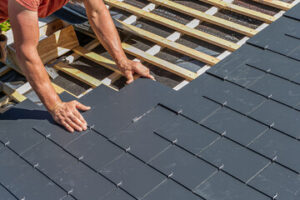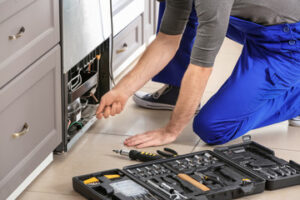Roofers use a wide variety of tools and materials. For example, they install flashing around chimneys, windows and joints to keep water from seeping in those areas.

They also install ridge vents to ensure that roofs shed rainwater properly. To perform these tasks, a roofer needs a tape measure, a ladder and a notepad and pencil to record measurements.
Unless you’re planning on re-roofing (placing new roofing materials over existing ones), your roof must be torn off before your new one can go on. This may seem like an unnecessary step, but it’s vital to ensure that the sheathing and other roof components are in good condition. It also reveals any hidden damage to the structure, which your roofing contractor can then repair before installing the new roof.
Your roofing professional will start by removing the old shingles or tiles from your roof. They’ll carefully pry each one off, trying to avoid damaging the roof decking or other roof elements. They’ll also remove any metal flashing, which is often found around vents and other roof features, and they’ll pull off the gutter downspouts if necessary.
Once the shingles are removed, your roofing contractor will clean up the site. They’ll spread a tarp under the section they’re working on, which will catch the falling debris and make cleanup much easier. They’ll also cover any plants and other objects that could be damaged by the shingle debris. If there’s a koi pond in your yard, they’ll put a tarp over it, too.
While ripping off the old roof, your roofing contractor will also check for any water leaks or other problems that need to be addressed. They’ll also take a look at the eave drip edge, underlayment, and pipe boot flashing, as well as any metal or plastic vents.
This is a big job, and it’s best to do it during good weather. It takes a lot of physical labor to rip off a roof, and you want to be sure that the work is done safely. It’s important to be able to climb ladders and handle heavy bundles of shingles, so if you’re not comfortable with this type of work, it’s best to hire a professional. If you’re doing the job yourself, it’s a good idea to rent a large trash container for your old roof debris, and be sure to cover anything nearby that you don’t want shingle scraps to land on, such as landscaping, a garden shed, or your car.
Preparing Your Home
While it may be tempting to request multiple roofing quotes, you’ll save both money and time by making a decision on your preferred roofing contractor before starting the work. While this does require a little extra planning, it ensures that you’re not wasting time or money by changing your mind.
Before the roofers come, you can prepare your home by removing or covering any items that you don’t want to get damaged during the project. This includes a patio cover, furniture, plants, and other items that are exposed to the elements during roof installation. Taking the time to move these items before your new roof is installed will allow you to enjoy them for years to come without worrying about damage.
The hammering and scraping of the roof will create vibrations that can cause wall decorations to fall off, including mirrors, wreaths, and framed photos. You should also remove any decorations that are located on the top floors of your home, as they can be knocked off by the hammering and debris.
In addition, you’ll want to take down any satellite or cable dishes that are located on your roof. This allows the roofing contractors to safely work on your roof and protects them from any falling debris that could damage the dishes.
You should also cover any landscaping features near your home with large tarps. The tarps will help to keep dirt and nails from getting into the plants and grass, as well as catch any stray shingles that fall off during the project.
Lastly, you should remove any outdoor toys or patio furniture that you don’t want to get dirty with dirt or dust. Your roofers will need to walk all around your house during the roof replacement, and you don’t want them tripping over your child’s toy or dragging in dust or debris from one area of your yard to another.
You should also make sure that your roofers have access to power outlets while they’re working on your roof. Exterior outlets are best, but if you don’t have any, your contractors can use extension cords that run through windows or doors. However, it’s a good idea to clear these outlets before the project starts to prevent any tripping hazards from occurring.
Installing the New Roof
A roof is the top surface of a building that protects against rain, snow, sunlight, wind, and extreme temperatures. It can be flat, pitched, vaulted or domed and may have a variety of finishes, materials and shapes. Depending on the weather in your area and the condition of your existing roof, it may be possible to re-roof instead of replacing it completely. Re-roofing can save you money and is usually faster than a complete roof replacement.
Once the old roof has been removed, the crew will install new flashing and drip edges. If the old flashing and drip edges are in good condition, the roofers will probably set them aside to reuse. The roofers will also inspect the sheathing or roof decking and replace any damaged boards. They will also install new underlayment, if necessary.
Next, the roofers will start laying down the shingles. Using the chalk line, they will begin at one edge of the roof and work their way across the roof, nailing each row as they go. Roofers use a tool called a pneumatic nailer to speed up the process and ensure that all the shingles are secure. They will also apply a roof caulk along the raw edges to make sure the seams are watertight.
The roofers will pay special attention to the valleys where two sloping sides meet. This is where water tends to pool, and the roofers will install flashing to keep water out. They will also install flashing around chimneys and exhaust vents. The last step of the shingling process is to install the ridge cap, which caps the peak of the roof and keeps it in place.
When the roofers have finished installing your new roof, they will clean up any debris that has fallen from your home and haul away the old roofing materials for proper disposal. They will also do a final inspection of the completed job to make sure it meets with their quality standards before leaving your home. The Brothers team has Field Quality Managers that review every job and make sure everything is done correctly.
Final Inspection
During this part of the inspection, your inspector will go inside the attic to visually inspect the condition of the roof. They’ll look for signs of sagging or uneven roof planes. They’ll also examine the condition of the gutter systems. And, of course, they’ll walk the entire roof to look at the nailing pattern and check that the underlayment is properly installed.
The final building inspection is one of the most important steps in the construction process, and it’s where you can find out whether your new home or commercial structure meets local codes. A failing final inspection can halt construction, costing you money and making the completion of your project a lot more stressful.
A final inspection is conducted after all work authorized by the building permit has been completed, and a certificate of occupancy (CO) has been issued or is otherwise available. The final inspection consists of a comprehensive review of the work, and an inspector will note any deficiencies or code violations that need to be corrected before occupying the facility.
It’s important for contractors to know what the inspector will be looking for during the final inspection, so they can prepare their construction site accordingly. Many inspectors provide a checklist for builders, and you can often find a full list on the website of your local building authority.
Typically, the contractor is responsible for scheduling the final inspection, though this can vary from case to case. They should be prepared with all the necessary documentation and be able to answer any questions or concerns the inspector might have.
If any issues are found during the final inspection, they should be addressed as quickly as possible to keep the closeout on schedule and on budget. This can be a difficult task, especially since many of the problems that need to be fixed aren’t easily visible, such as faulty wiring that’s covered by walls.
It’s common for building inspections to have a few minor discrepancies that need to be resolved, but this shouldn’t come as a surprise. Most of the time, building inspections are scheduled well in advance of the final inspection, so there’s no reason for issues to arise out of nowhere.

